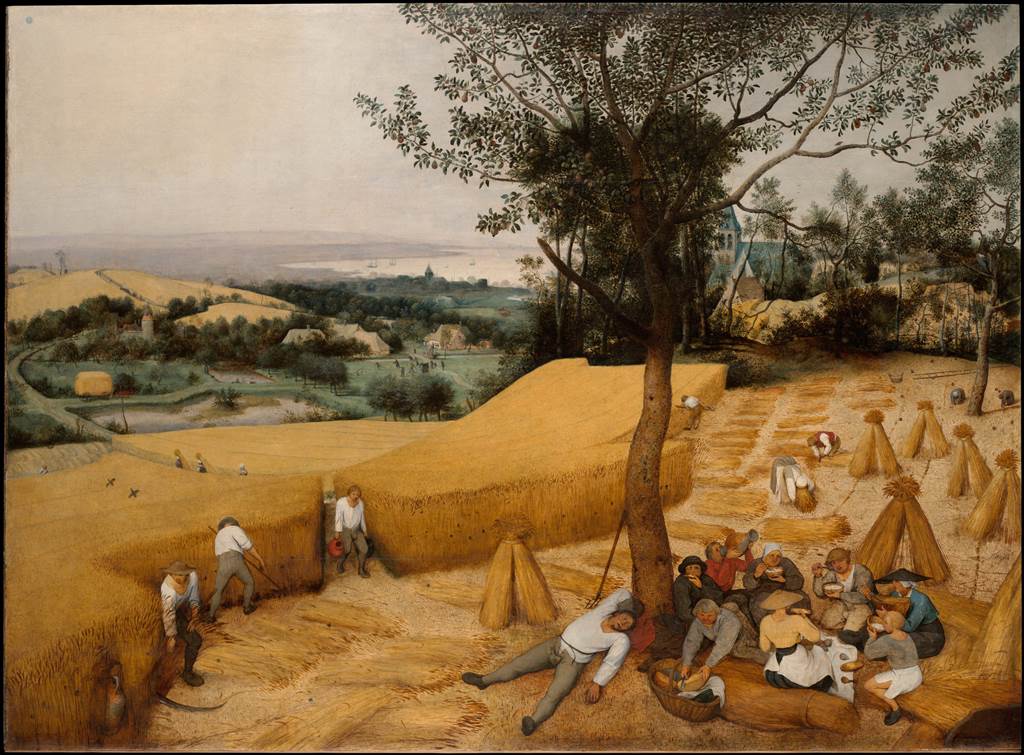Nosing around the Met‘s digitized collection a bit more, I came across “The Harvesters” by Pieter Bruegel the Elder from 1565. Not hard as it was on the front page. I have posted a few times about paintings by his son, the imaginatively named Pieter Bruegel the Younger, over the years but this one struck me as perhaps illustrating a few things worth thinking about.
Look at the scale of the people compared to the height of the grain. One of the characteristics of Battledore barley two hundred years later in Britain was that it had a short stalk. It could survive hail or wind better than other varieties but didn’t provide all that useful straw that we learned about in relation to beer in New York before the switch to barley from wheat. The stalk was in itself important to the community as a multi-purpose material for mattress stuffing to looser wheat mash spargings. In “The Harvesters” the stalks are tall and entire stooks* are taken from the field with care. The stooks are strong enough to serve as a bench for the workers having their meal.
Harvest time is big stuff. The image is a narrative of agricultural economy in the Renaissance. If you click on the image at the met site, you can zoom in quite closely. Look at how the topography is used to illustrate the economic activity. The field being harvested is on the top of a hill. Scythed and stooked, it is carried one by one to the bottom of the hill where it is loaded on a cart and carried away. There are three communities in the painting. The hilltop has a church to the upper left seen through the trees. Down below there is a manor of some sort where some are swimming while others are killing a tied up goose as a blood sport. In the far distance, there is a coastal town with ships in the harbour. Is one point of the painting’s structure that the grain gets exported? Or is beer made from the grain getting shipped out? I should cross reference the painting with Unger.
Where is this place? The blurb attached to the image by the Met says:
Bruegel’s series is a watershed in the history of western art. The religious pretext for landscape painting has been suppressed in favor of a new humanism, and the unidealized description of the local scene is based on natural observations.
But is this really a local scene or an imaginary one? Where is it? Bruegel lived in coastal Antwerp, Belgium a city of about 100,000 at the time and the richest in Europe. He was born in the river town of Breda, another community now in the Netherlands but then also in the Duchy of Brabant. Perhaps one of those two centres is in the background. Could you find the field and stand where the artist stood?
But what about the beer? As one commentator notes, the scene is about producing and consuming. Or – if you are the goose – producing, torturing then consuming. The workers are eating bread and cheese as well as pears that one guy is shaking from the tree to the upper right. And they are drinking. A central character is a man carrying two large jugs up the path. Another man in the circle having a meal drinks directly from a jug. A fourth jug with what looks like a loaf of bread on top sits in the uncut wheat to the lower left.
We are told by Markowski that saison and biere de garde were brewed for centuries in the Low Countries and northern France to attract and retain workers. Farmhouse beers. The scene in “The Harvesters” is smack-dab in the middle of that culture, in the saison zone that included Brabant. Unger explains that particularly in the sixteenth century, tax records indicate a wide number of names for various grades of beer: “… dun and scheynbier and volksbier and scharbier and scherbier all turn up. No matter the name, it was always cheap.”** Was that what was in the jugs? We can’t reach back to ask those in the picture what they called their drink or even if it was in fact beer. But it could be and, frankly, likely was so… it is what it was. Day drinking 1565.
*I use the SW Ontario usage, spelling and pronunciation of the in-laws.
**at page 129.

